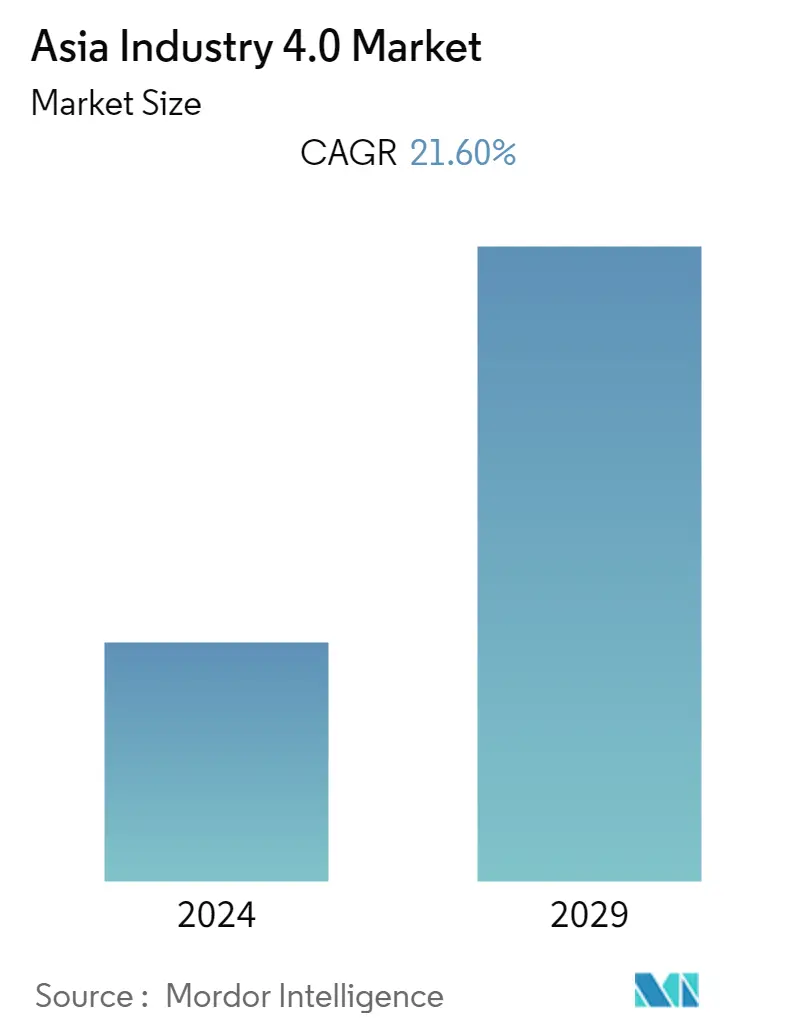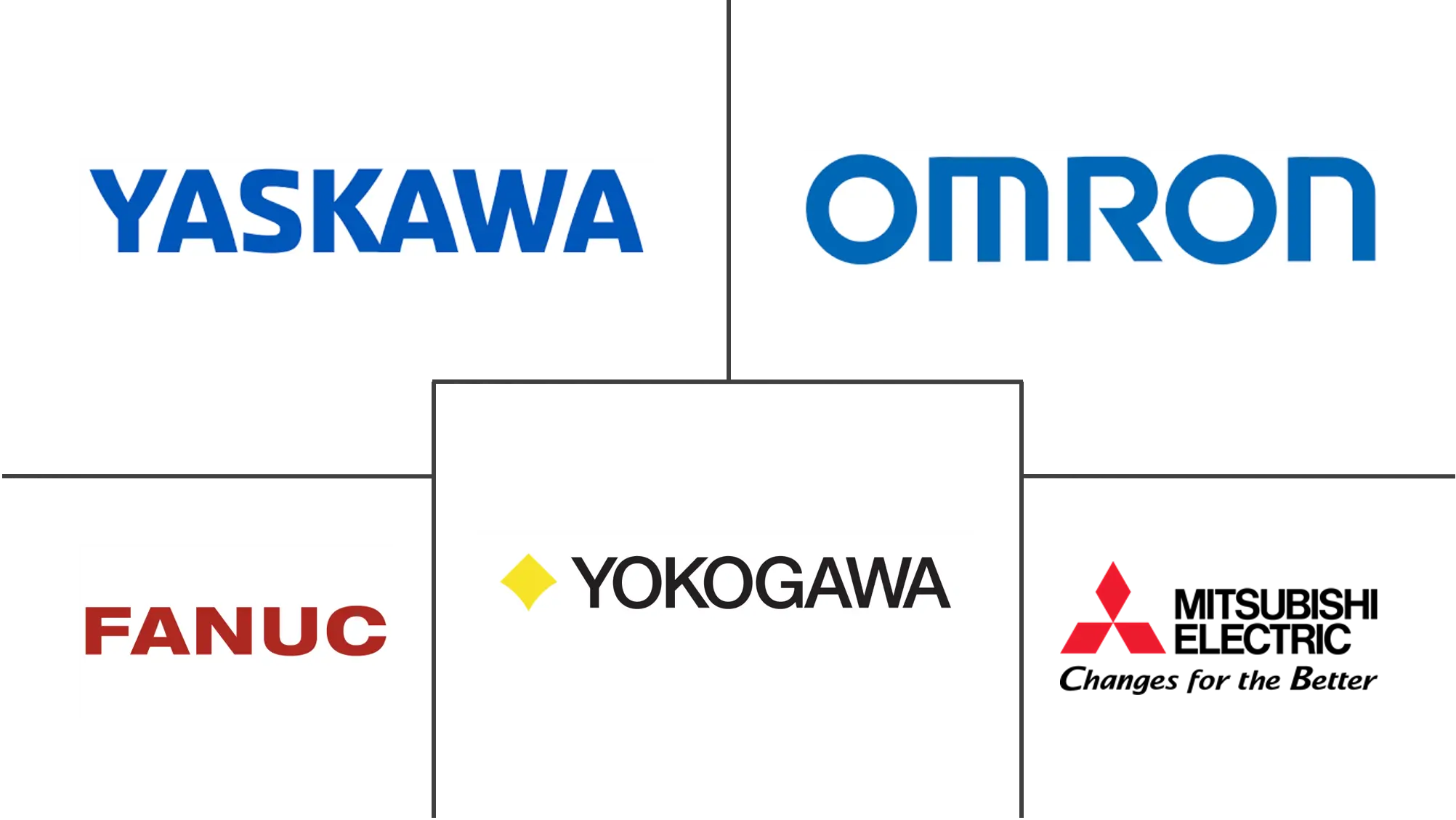Market Size of Asia Industry 4.0 Industry

| Study Period | 2019 - 2029 |
| Base Year For Estimation | 2023 |
| Forecast Data Period | 2024 - 2029 |
| Historical Data Period | 2019 - 2022 |
| CAGR | 21.60 % |
| Market Concentration | Low |
Major Players
*Disclaimer: Major Players sorted in no particular order |
Asia Industry 4.0 Market Analysis
The Asian Industry 4.0 market is expected to register a CAGR of 21.6% over the forecast period. Digitization and the Industry 4.0 revolution act as catalysts for the growth of automation among manufacturing industries by using smarter and automated solutions, such as robotics and control systems, that enhance the performance metrics of the production processes.
- Asia has been an early adopter of technological advancements. The market in these developing economies poses a key advantage in implementing industrial automation since they are not tormented by rebuilding legacy automation systems and machine investments.
- Robotics is crucial to China's smart manufacturing ambitions and comprehensive industrial policy. A slightly different variation in the configuration of the government agencies (with MIIT again at the helm) announced a related 5-year development plan for the robotics industry in 2022 as the release of the smart manufacturing development plan. The fast pace toward the 5G-powered industry revolution 4.0 is on, and China has a strong head start.
- According to Huawei, critical communications solutions based on industrial-grade private wireless offer unimaginable possibilities to the power Industry 4.0 use cases, from machine remote control to cloud robotics, process automation, predictive asset maintenance, assisted/autonomous vehicles, CCTV monitoring, and mission-critical push-to-talk and push-to-video, all on a single network infrastructure.
- Technological changes in the last decade revolutionized the organization of industrial production, influencing production processes and supply chains. Industry 4.0, hereafter, has integrated new technologies such as AI, IoT, ML, cloud computing, and analytics into manufacturing production operations and processes, propelling a new era of smart manufacturing. Digital technologies in manufacturing promote automation and self-optimization, leading to the efficiency of operations across the value chain in the region.
- Industry revolution 4.0 is fuelled by four significant components: hyper-efficient processing technology (chips), widespread internet penetration, machine learning, and artificial intelligence. While the waves of automation due to past industrial revolutions popularised the mass-homogeneous production systems, Industry 4.0 brings more customized industrial production to the fore. With Industry 4.0, new production models are emerging where 3-D printers, automated systems, robots, data exchanges, and data exchanges are used effectively in an environment of smart factories. This will make the production processes lean and flexible, enabling optimum resource utilization.
- As Asian countries experienced strict lockdowns during the COVID-19 pandemic, the developments concerning Industry 4.0 were impacted for 6-8 months. Factory closures and shifts in investments were primary factors for the same. Multiple vendors of factory automation solutions shut their facilities in the wake of curbing the spread of the virus. Innovative technologies, such as artificial intelligence (AI), mass automation, industrial communications, big data, robotics, and 3D printing, are transforming the regional manufacturing landscape post-pandemic.
Asia Industry 4.0 Industry Segmentation
Digital transformation in the manufacturing industry marks the advent of Industry 4.0, which addresses several global issues. It modernizes and automates the supply chains of manufacturing companies, which not only helps in data-driven planning but also provides a competitive advantage over counterparts and helps the companies stay ahead in the market. Technologies like industrial robotics, IIoT, 3D printing, artificial intelligence, and machine learning are some technologies used across different manufacturing organizations.
The Asian Industry 4.0 Market is Segmented by Technology Type (Industrial Robotics, IIoT, AI and ML, Blockchain, Extended Reality, Digital Twin, 3D Printing, Other Technology Types), End-user Industry (Manufacturing, Automotive, Oil and Gas, Energy and Utilities, Electronics and Foundry, Food and Beverage, Aerospace and Defense, Other End-user Industries), and Country (China, South Korea, Japan, India, Indonesia, Rest of Asia). The market sizes and forecasts are provided in terms of value in USD million for all the above segments.
| By Technology Type | |
| Industrial Robotics | |
| IIoT | |
| AI and ML | |
| Blockchain | |
| Extended Reality | |
| Digital Twin | |
| 3D Printing | |
| Other Technology Types |
| By End-user Industry | |
| Manufacturing | |
| Automotive | |
| Oil and Gas | |
| Energy and Utilities | |
| Electronics and Foundry | |
| Food and Beverage | |
| Aerospace and Defense | |
| Other End-user Industries |
| By Country | |
| China | |
| South Korea | |
| Japan | |
| India | |
| Indonesia | |
| Rest of Asia |
Asia Industry 4.0 Market Size Summary
The Asian Industry 4.0 market is experiencing significant growth, driven by the rapid adoption of digital technologies and automation solutions across manufacturing sectors. This transformation is facilitated by the region's early embrace of technological advancements, allowing countries to implement industrial automation without the burden of outdated legacy systems. The integration of technologies such as AI, IoT, and cloud computing is reshaping production processes, enhancing efficiency, and enabling smart manufacturing. Countries like China and Japan are at the forefront, with China focusing on robotics and smart manufacturing, while Japan leverages its advanced automation technologies to maintain its status as a global leader in production process automation. The COVID-19 pandemic temporarily disrupted these advancements, but the post-pandemic recovery has seen a resurgence in the adoption of innovative technologies, further propelling the Industry 4.0 movement in Asia.
The competitive landscape of the Asian Industry 4.0 market is characterized by the presence of numerous small and large players, including major corporations like Mitsubishi Electric, Omron Corporation, and Yokogawa Electric Corporation. These companies are actively involved in initiatives to enhance digital transformation and the adoption of Industry 4.0 technologies. For instance, Mitsubishi Electric has expanded its presence in Singapore and Thailand, focusing on integrating IIoT services and private 5G solutions to support smart manufacturing. Similarly, Yokogawa Electric Corporation has introduced cloud-based asset monitoring services to optimize asset performance globally. The region's manufacturing industry, particularly in countries like India and Japan, is witnessing increased investment and development in automation and digital technologies, positioning Asia as a key player in the global Industry 4.0 landscape.
Asia Industry 4.0 Market Size - Table of Contents
-
1. MARKET INSIGHTS
-
1.1 Market Overview
-
1.2 Industry Attractiveness - Porter's Five Forces Analysis
-
1.2.1 Bargaining Power of Suppliers
-
1.2.2 Bargaining Power of Consumers
-
1.2.3 Threat of New Entrants
-
1.2.4 Threat of Substitutes Products
-
1.2.5 Intensity of Competitive Rivalry
-
-
1.3 Impact of COVID-19 on the Market
-
-
2. MARKET SEGMENTATION
-
2.1 By Technology Type
-
2.1.1 Industrial Robotics
-
2.1.2 IIoT
-
2.1.3 AI and ML
-
2.1.4 Blockchain
-
2.1.5 Extended Reality
-
2.1.6 Digital Twin
-
2.1.7 3D Printing
-
2.1.8 Other Technology Types
-
-
2.2 By End-user Industry
-
2.2.1 Manufacturing
-
2.2.2 Automotive
-
2.2.3 Oil and Gas
-
2.2.4 Energy and Utilities
-
2.2.5 Electronics and Foundry
-
2.2.6 Food and Beverage
-
2.2.7 Aerospace and Defense
-
2.2.8 Other End-user Industries
-
-
2.3 By Country
-
2.3.1 China
-
2.3.2 South Korea
-
2.3.3 Japan
-
2.3.4 India
-
2.3.5 Indonesia
-
2.3.6 Rest of Asia
-
-
Asia Industry 4.0 Market Size FAQs
What is the current Asia Industry 4.0 Market size?
The Asia Industry 4.0 Market is projected to register a CAGR of 21.60% during the forecast period (2024-2029)
Who are the key players in Asia Industry 4.0 Market?
Mitsubishi Electric, Omron Corporation, Yokogawa Electric Corporation, Fanuc Corporation and Yaskawa Electric Corporation are the major companies operating in the Asia Industry 4.0 Market.

